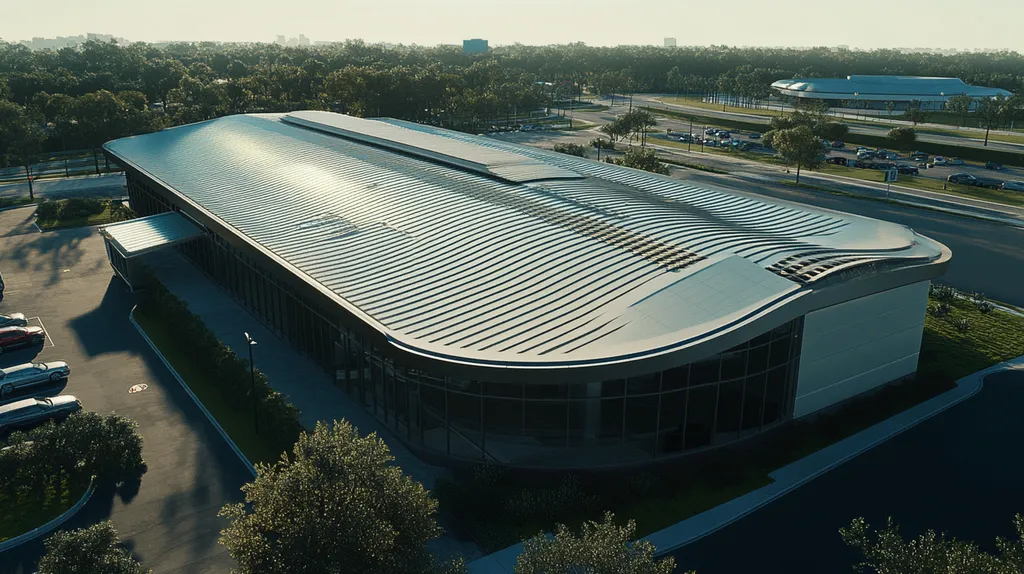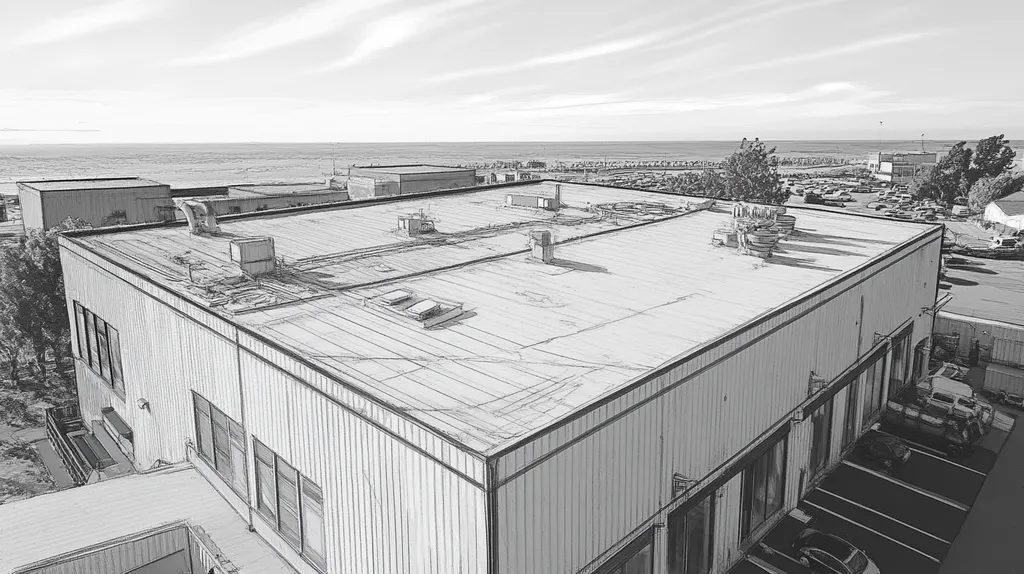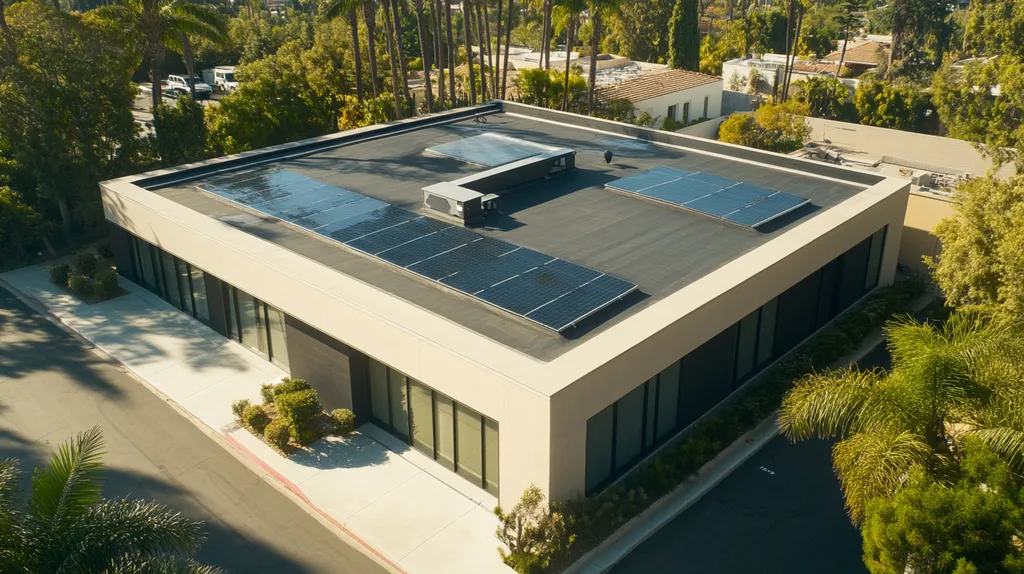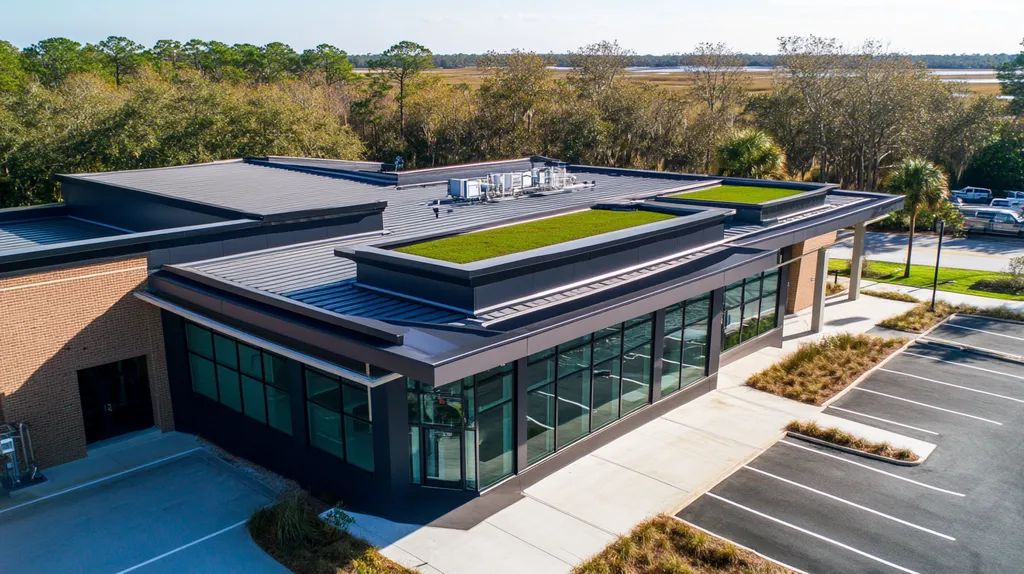In industrial facilities across America, outdated lighting maintenance practices are quietly draining budgets and compromising safety. Studies show that poor industrial lighting contributes to 30% of workplace accidents, yet most facilities continue following maintenance protocols established decades ago.
From sporadic inspections to reactive repairs, these entrenched practices not only waste energy but also put workers at risk. The cost? An estimated $3.6 billion annually in wasted energy and preventable accidents.
This analysis challenges conventional maintenance approaches, revealing how systematic failures, overlooked opportunities, and root causes converge to create an unsustainable status quo in industrial roof lighting maintenance.
SECTION 1: CURRENT PRACTICES
Lighting maintenance on industrial roofs may seem like an afterthought, but it’s a significant player in keeping operations safe and efficient. Did you know that nearly 30% of industrial accidents stem from poor lighting? This stark reality underscores the importance of regular upkeep. Unfortunately, many facilities adopt sporadic inspection routines and reactive repairs, which can lead to costly and dangerous missteps. This section highlights common maintenance approaches and the shortcomings that can disrupt smooth warehouse operations.
Ad Hoc Maintenance Schedules
In many facilities, maintenance operates on a haphazard schedule, tackling issues only as they arise. While this quick-fix mindset might seem efficient, it can incur substantial long-term costs. For example, a lighting fixture that goes dark can unexpectedly halt productivity, impacting both safety and output.
Moreover, this reactive maintenance approach often neglects critical aspects of lighting systems. Facilities may prioritize bulb replacements while ignoring essential checks on wiring and fixtures. This oversight can set off a domino effect of failures, increasing the risk of accidents.
As safety regulations tighten, a slapdash maintenance schedule exposes facilities to potential legal troubles and fines. A comprehensive maintenance strategy is crucial not only for compliance but also for enhancing overall operational effectiveness.
By implementing a systematic maintenance schedule, facilities can anticipate failures and maintain optimal lighting performance. A structured approach not only curtails costs but also fosters a safer workplace.
Inadequate Inspection Protocols
Current inspection practices for industrial roof lighting often fall woefully short. Many facilities lean on basic checklists that oversimplify the complex nature of lighting installations. A cursory inspection risks overlooking hidden issues, such as corrosion or loose connections, which can ultimately lead to system failures.
Conducting inspections just once or twice a year misses the evolving conditions that can influence lighting systems, particularly in exposure-rich environments. Regular assessments are essential to nip potential problems in the bud, preventing situations that could endanger staff.
The absence of thorough inspection protocols also hampers effective energy efficiency evaluations. Without comprehensive assessments, facilities may remain blissfully unaware of energy waste and inflated operational costs.
Establishing a multi-layered inspection approach—combining visual and operational checks—can amplify the reliability of lighting systems. A commitment to detail in maintenance fosters improved safety and operational success.
Reactive vs. Proactive Approaches
The prevailing trend in the industry favors reactive maintenance practices, waiting until issues arise to take action. This creates a cycle of crisis management, detracting attention from strategic long-term planning. In contrast, a proactive maintenance approach emphasizes routine assessments and anticipatory repairs, significantly decreasing potential disruptions.
Adopting proactive maintenance not only mitigates risks but also enhances the lifespan of lighting systems. For instance, replacing worn-out components before they fail can avoid the costly emergency repairs that disrupt workflows. Facilities that embrace a proactive stance typically enjoy improved productivity and reduced maintenance expenses.
Additionally, shifting towards proactive strategies can positively influence workplace culture by demonstrating a commitment to safety. Employees appreciate a well-lit, well-maintained environment, leading to improved morale and performance.
Transitioning from a reactive framework to a proactive strategy requires careful planning and investment. However, the long-term benefits—safer environments and enhanced productivity—far outweigh the upfront costs.
SECTION 2: SYSTEMIC ISSUES
The maintenance of lights on industrial roofs is often plagued by systemic issues, placing safety and efficiency at risk. Without standardized procedures, facilities struggle with inconsistencies that can lead to accidents and performance delays. Inadequate resource allocation can inflate operational costs, while neglecting safety protocols endangers both personnel and the facility. These systemic flaws must be addressed to ensure compliance and maintain a well-lit, secure environment for operations.
Lack of Standardized Procedures
The absence of uniform maintenance procedures poses significant challenges for roof lighting care. When maintenance schedules vary, some lights may receive ample attention while others are left in the dark, creating uneven illumination across expansive areas. This inconsistency not only diminishes visibility for employees but can also jeopardize equipment and materials stored in poorly lit areas.
Furthermore, without documented protocols, training new staff becomes a daunting task. Employees might overlook essential duties, such as replacing bulbs or cleaning fixtures, amplifying potential safety hazards. Establishing a set of standardized procedures is critical for ensuring reliable performance and safety in roof lighting.
Facilities should develop a structured framework for monitoring and maintaining their lighting systems. Utilizing a checklist or digital management tools can help streamline this process, simplifying adherence to safe practices and fostering consistent performance.
Standardization ultimately promotes accountability; everyone understands their responsibilities and their impact on safety and efficiency, cultivating a culture of reliability in facility management.
Inefficient Use of Resources
Inefficient resource allocation frequently leads to excess expenses in maintaining industrial roof lighting. Too often, facility managers rely on reactive maintenance, addressing problems only when they escalate. This short-sighted approach can escalate costs rather than curtail them, as neglecting minor repairs can result in major damage and inflated replacement expenses.
Additionally, the continued use of outdated technologies and practices can increase energy waste. For example, relying on older bulb styles instead of energy-efficient LEDs can result in soaring electricity bills while causing higher failure rates. Transitioning to modern solutions can significantly alleviate financial pressures.
Regular audits of lighting systems can help facilities pinpoint inefficiencies and prioritize upgrades based on objectives rather than on crisis management. This forward-thinking strategy not only trims costs but also contributes to a more sustainable operation.
A successful maintenance strategy cleverly weaves together predictive and preventive maintenance, focusing resources where they will yield the most value—both financially and operationally.
Neglect of Safety Protocols
Neglecting safety protocols in industrial roof lighting maintenance introduces serious risks. Insufficient safety measures can lead to accidents during maintenance, exposing workers to potential fall hazards or electrical shocks. For example, staff may work without appropriate harnessing or safety equipment while conducting repairs on rooftops.
Moreover, neglecting safety procedures can result in non-compliance with industry regulations, leading to substantial fines or legal consequences. OSHA imposes specific safety standards to be followed during roof work, and any deviations can have significant repercussions for organizations.
To mitigate these risks, it’s vital for facilities to implement a robust safety training program for all maintenance personnel. Regular drills and educational sessions can instill a safety-first mindset, ensuring adherence to established best practices.
Prioritizing safety protects employees and enhances the overall integrity of the facility, promoting operational continuity. A well-designed safety protocol serves as the foundation of an effective roof lighting maintenance strategy.
SECTION 3: MISSED OPPORTUNITIES
Many industrial facilities are overlooking golden opportunities to enhance energy efficiency and trim costs through outdated lighting maintenance practices. A staggering statistic reveals that nearly 30% of energy in commercial buildings is dedicated to lighting. By neglecting advanced technologies and failing to exploit natural light, property owners and facility managers might be missing out on substantial savings, all while inadvertently compromising safety and productivity. This section highlights these critical areas of oversight that, if addressed, could transform operations.
Overlooking Energy Efficiency
Energy efficiency often takes a backseat in traditional lighting maintenance routines, resulting in avoidable expenses. Many facilities cling to antiquated fluorescent fixtures that drain excessive power compared to sleek, modern LED alternatives. By making the switch to LED lighting, businesses can slash energy consumption by up to 75%, leading to impressive savings over time.
Moreover, energy-efficient systems tend to extend the lifespan of lighting fixtures, reducing both replacement frequency and maintenance costs. Facilities embracing energy efficiency not only minimize their carbon footprint but may also access incentives and rebates from energy providers, further easing their investment burden.
To fully reap the benefits of energy-efficient technologies, regular audits and upgrades should be woven into maintenance plans. Ignoring these strategies equates to throwing money down the drain and missing the chance to flaunt corporate responsibility.
Ultimately, integrating energy-efficient lighting is not just an option; it’s a pressing necessity for modern industrial facilities intent on cutting expenses and enhancing operational effectiveness.
Ignoring Advanced Technologies
Advanced technologies in lighting management are often sidelined during routine maintenance assessments. Smart lighting systems equipped with sensors and controls can drastically improve energy management while boosting safety. For instance, motion sensors can ensure that lights only illuminate when needed, drastically reducing energy waste.
Additionally, these advanced systems can empower better maintenance through real-time data analytics. This capability allows for early detection of faults or inefficiencies, potentially averting operational downtime. Facilities that neglect to adopt these technologies forfeit the opportunity to maximize their infrastructure’s efficacy.
Regularly incorporating technological updates into maintenance schedules not only bolsters efficiency but also keeps facilities competitive in an ever-evolving market. Overlooking these advancements may leave facilities trapped in outdated practices that fall short of today’s operational demands.
Leveraging innovative technologies in lighting maintenance paves the way for a more responsive and agile facility management approach.
Disregarding Daylight Utilization
Daylight utilization represents another often-overlooked avenue in industrial roof lighting maintenance. Harnessing natural light can dramatically lessen dependence on artificial sources, leading to reduced energy costs. Designing workspaces that prioritize daylight creates a safer, more productive atmosphere.
Incorporating skylights or employing reflective materials can significantly enhance natural light penetration. This strategic move not only decreases energy expenses but also positively impacts employee well-being, as studies suggest natural light exposure boosts productivity and morale.
Regular assessments of roof lighting systems for opportunities to utilize daylight should be an integral part of any comprehensive maintenance plan. Failing to adopt natural light strategies leads to inefficiencies and forfeits chances for optimal performance.
By embracing daylight utilization, facilities can cultivate a sustainable and dynamic workspace while reaping financial rewards.
SECTION 4: ROOT CAUSES
Identifying the root causes of lighting maintenance issues on industrial roofs is a pressing necessity. Facilities dealing with inadequate lighting often suffer costly downtime, while research reveals that poor lighting can diminish employee productivity by up to 20%. By addressing three critical areas—insufficient training, poor inventory management, and inadequate record keeping—property owners can significantly enhance their lighting maintenance strategies, leading to safer and more efficient work environments.
Insufficient Training for Staff
The primary culprit behind ineffective lighting maintenance is a lack of adequate training for facility staff. Employees frequently lack the know-how to perform essential inspections and spot potential issues early on. This knowledge gap can turn minor inconveniences into major repairs, posing serious risks to workplace safety.
Without robust training, maintenance personnel may overlook vital warning signs such as flickering lights or unusual energy consumption patterns. These indicators often reveal underlying problems that could result in complete lighting failures if not swiftly addressed.
Moreover, training programs can sometimes be inconsistent. New staff may not receive comprehensive onboarding, resulting in a workforce that’s ill-equipped to uphold quality lighting standards. This inadequacy impacts safety and operational efficiency, creating a precarious situation.
Investing in thorough training for all facility personnel equips everyone with the knowledge necessary to maintain industrial roof lighting effectively. A well-trained team can significantly reduce response times for repairs, ultimately saving money and enhancing workplace conditions.
Poor Inventory Management
Poor inventory management emerges as another critical issue undermining lighting maintenance. Many facilities struggle to consistently track replacement bulbs, fixtures, and critical components. A faulty supply chain can lead to frustrating delays in repairs when equipment fails, resulting in unnecessary downtime.
For example, if a facility doesn’t maintain adequate stock levels, a burned-out light might go unaddressed for days, creating unsafe working conditions and interrupting essential operations. Such situations can lead to financial losses and diminish productivity.
Moreover, a disorganized inventory can cause over-ordering or underutilization of resources, which can inflate maintenance costs and deplete capital that could be used in more vital areas.
Implementing a robust inventory management system ensures that essential materials are readily available. Facilities that proactively manage their inventories will be better positioned to respond swiftly to lighting issues, enhancing both safety and productivity.
Inadequate Record Keeping
Inadequate record keeping is another significant contributor to subpar lighting maintenance. Many facilities fail to thoroughly document maintenance activities, repairs, and recurring issues. This lack of records complicates the process of identifying patterns or persistent problems, ultimately hindering effective decision-making.
For instance, without a comprehensive maintenance history, a facility may not recognize that certain lighting fixtures are prone to failure more frequently than others. This insight is critical for making informed decisions regarding replacements and upgrades to improve reliability.
Additionally, poor documentation can impede compliance with safety regulations, as regulatory bodies often require maintenance records to ensure safety and operational integrity. Missing documentation may lead to fines or penalties.
By establishing an efficient record-keeping system, facilities can better understand their lighting maintenance needs. Comprehensive documentation also aids in forecasting future maintenance requirements, ensuring that budgets are allocated effectively.
DATA DRIVEN EVIDENCE
In the world of industrial roofing, the maintenance of lighting often lurks in the shadows, underappreciated yet crucial for maximizing energy efficiency and managing operational costs. A striking statistic reveals that over 30% of energy consumed by industrial buildings comes from lighting. This fact emphasizes the need for property owners and facility managers to reassess their maintenance approaches. Addressing these critical issues not only leads to substantial savings but also enhances safety. The following subsections delve into energy consumption statistics, maintenance costs, and efficiency metrics.
Energy Consumption Statistics
Energy consumption shapes the operational landscape in industrial settings. The U.S. Department of Energy reports that commercial buildings waste about 30% of their energy due to inadequate lighting systems. Regular maintenance can unearth issues like outdated fixtures or lenses obstructed by dirt, both of which diminish light output and squander energy.
Swapping old bulbs for energy-efficient LEDs can cut energy usage by up to 75%. With a commitment to regular maintenance, facilities can ensure their lighting systems operate at peak performance, slashing wasteful expenses. Moreover, outdated fixtures can create uneven light distribution, necessitating additional lighting for safe working conditions. Routine inspections can identify and resolve these problems, leading to a more effective lighting strategy.
In summary, grasping energy consumption statistics is vital for creating strategic improvements in lighting maintenance, ultimately resulting in cost reductions and enhanced sustainability.
Maintenance Cost Analysis
The financial implications of neglecting lighting maintenance are both significant and far-reaching. Research from the National Institute of Standards and Technology reveals that unplanned maintenance can inflate costs by 10 to 20 times compared to scheduled maintenance. This disparity underscores the urgency to champion proactive strategies.
Routine inspections catch minor issues before they snowball, while also ensuring compliance with safety standards. By adopting a structured maintenance schedule, facilities minimize potential liabilities related to accidents stemming from poor lighting conditions. Furthermore, considering maintenance costs shows that investing in innovative technologies—like smart lighting systems—can yield long-term savings. These systems adapt in real-time, enhancing energy efficiency and reducing wear on fixtures.
In conclusion, analyzing maintenance costs illuminates a compelling argument for re-evaluating current practices. Strategic investments in lighting maintenance can create a favorable financial landscape for industrial facilities.
Efficiency Metrics and Benchmarks
Efficiency metrics are essential for evaluating the performance of lighting systems and identifying areas for improvement. Key measurements, such as lumens per watt, help assess how effectively energy is converted into light. Many industries benchmark against established standards to gauge their performance.
The Illuminating Engineering Society advises that industrial facilities should achieve at least 75 lumens per watt. Yet, many fall short due to outdated equipment and insufficient maintenance. Regular assessments can pinpoint underperforming fixtures that detract from overall lighting efficiency.
Additionally, incorporating smart technologies enhances monitoring and data collection, yielding valuable insights into usage patterns and performance trends. This data-driven approach informs effective scheduling of maintenance tasks, ensuring optimal system efficiency.
Moreover, utilizing efficiency metrics can help organizations comply with green building standards. Meeting these standards not only boosts marketability but also opens doors to incentives and rebates, further elevating the financial viability of the facility.
In summary, focusing on efficiency metrics and benchmarks fosters improved lighting systems that contribute to cost savings, safety, and operational effectiveness.
SECTION 6: ALTERNATIVE SOLUTIONS
When it comes to industrial roof lighting maintenance, simply keeping the lights on is not enough. Traditional re-lamping schedules often fall short, leading to inefficiencies and potential safety hazards. With studies revealing that around 30% of commercial lighting systems operate below optimal efficiency, it’s crucial for property owners and facilities managers to consider alternative strategies. This section introduces three innovative solutions that promise to enhance lighting effectiveness while trimming overall maintenance costs.
Scheduled Group Re-Lamping
One refreshing alternative is the implementation of a scheduled group re-lamping strategy. Rather than replacing bulbs haphazardly, facility managers can proactively plan to change out all lights at regular intervals. This ensures consistent light performance across rooftops, enhancing safety and visibility for the workforce.
This method not only simplifies labor and inventory management but also smartly reduces the likelihood of some lights burning out unexpectedly. By tackling maintenance en masse, dark spots are minimized and the workplace remains well-lit, making it safer for personnel navigating the roof.
Moreover, collective re-lamping proves economically savvy. Facilities can negotiate bulk rates with service providers, streamlining costs and enhancing budget predictability. In the long run, this organized maintenance strategy not only elevates the building’s value but also preserves the roof’s structural integrity.
In essence, scheduled group re-lamping shifts the paradigm from a reactive to a proactive maintenance posture, allowing facilities to uphold safety standards while managing expenses effectively.
Implementing LED Upgrades
Transitioning to LED lighting is another transformative solution for industrial roof lighting maintenance. LEDs consume significantly less energy than traditional bulbs and boast an impressive lifespan of 25,000 hours or more, reducing the frequency of both replacements and maintenance calls.
The brightness of LED lights contributes positively to workplace safety by enhancing visibility on rooftops. This boost in light levels not only aids maintenance personnel but also improves the functioning of rooftop equipment. Facilities that switch to LEDs often report remarkable reductions in energy consumption, leading to lower electricity bills.
On an eco-friendly note, LEDs are a greener option, free from harmful substances like mercury. This commitment to sustainability not only demonstrates corporate responsibility but also enhances the company’s image in an increasingly green-conscious world.
With the myriad benefits—including lower energy costs, longevity, and improved safety—it’s a strategic move that positions upgrading to LED lighting as a top priority in any industrial roof management plan.
Integrating Smart Lighting Controls
Smart lighting controls represent a cutting-edge solution that can revolutionize maintenance practices on industrial rooftops. These systems utilize sensors to automatically adjust lighting based on daylight levels and occupancy, maximizing energy savings while ensuring functional illumination.
By incorporating smart technology, facilities gain the ability to monitor lighting systems remotely. Instant notifications about burnt-out bulbs or malfunctions ensure swift responses, enhancing safety and improving workflow efficiency. This seamless integration streamlines maintenance planning, ensuring that lighting aligns with actual usage needs.
Additionally, smart lighting generates valuable data insights about usage patterns and performance metrics. Facility managers can use this information to refine re-lamping schedules and adjust lighting strategies for peak operational times, creating a responsive maintenance environment.
In summary, adopting smart lighting controls is a forward-looking approach to addressing the maintenance needs of industrial roofs. This technology positions facilities for ongoing operational success while prioritizing both safety and cost-effectiveness.
Moving Forward
The $3.6 billion wasted annually on inefficient industrial roof lighting represents more than just squandered resources—it signals a critical breakdown in facility management practices that demands immediate attention.
While traditional maintenance approaches continue draining budgets and compromising safety, the data clearly shows that implementing structured protocols, embracing smart technologies, and adopting proactive strategies can slash energy costs by up to 75%.
The path forward requires abandoning outdated practices in favor of systematic maintenance schedules, LED upgrades, and intelligent control systems.
With workplace accidents linked to poor lighting rising by 30% annually, facility managers can no longer afford to illuminate their operations with antiquated methods that prioritize quick fixes over sustainable solutions.
The time for transformation in industrial roof lighting maintenance isn’t on the horizon—it’s now.
FREQUENTLY ASKED QUESTIONS
Q. What are current maintenance practices for industrial roofs?
A. Many facilities use reactive maintenance, addressing issues only when they arise. This can lead to costly downtime and safety risks due to neglected checks on electrical components. A more routine approach can help identify problems before they escalate, ensuring reliable lighting performance and reducing unexpected failures.
Q. How does a lack of standardized procedures affect commercial roofs?
A. Without standardized procedures, lighting maintenance can become inconsistent. Some areas may be well-lit while others suffer from neglect, risking employee safety. Establishing clear protocols ensures that all lights receive equal attention, promoting a safer and more efficient workplace.
Q. What energy efficiency opportunities are overlooked in industrial roofs?
A. Facilities often stick to outdated lighting systems that waste energy. Switching to LED technology and using natural light solutions can lead to significant cost savings. Implementing these measures as part of maintenance can dramatically improve energy efficiency.
Q. Why is insufficient staff training a problem for industrial roof maintenance?
A. Lack of training often prevents employees from spotting early signs of lighting issues. This oversight can lead to more significant problems down the road, resulting in costly repairs and potential safety hazards. Providing comprehensive training ensures that staff can maintain lighting effectively.
Q. How can poor inventory management impact commercial roof lighting?
A. A disorganized inventory can delay necessary repairs when lights fail. If supplies run low, facilities might face unsafe conditions while waiting for replacements. Efficient inventory management helps ensure that parts are available when needed, promoting quick resolutions to lighting problems.
Q. What alternative solutions exist for industrial roof lighting maintenance?
A. Alternatives like scheduled group re-lamping, LED upgrades, and smart lighting controls can enhance efficiency. These strategies not only improve visibility but can also significantly decrease energy costs. Incorporating advanced technologies and planning into maintenance practices ensures better performance and safety.
Q. How can data-driven evidence enhance industrial roof lighting maintenance?
A. Analyzing energy consumption, maintenance costs, and efficiency metrics can identify key areas for improvement. Facilities can use this data to prioritize proactive maintenance and technological upgrades to enhance lighting performance, ultimately leading to better operational outcomes and cost savings.











